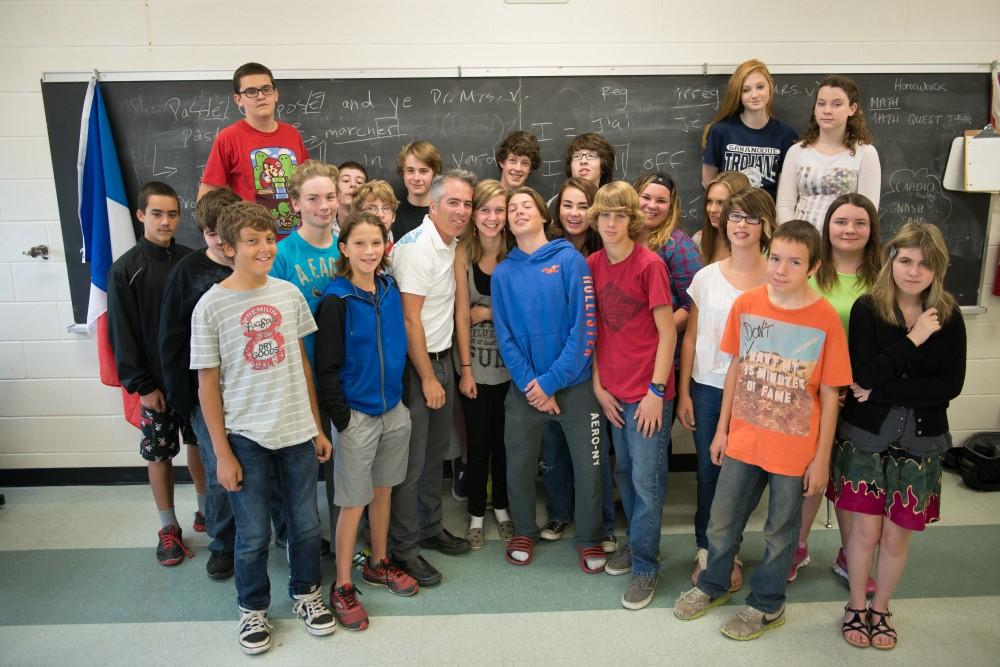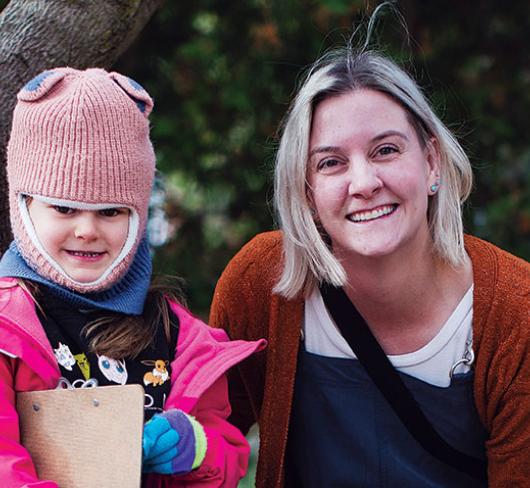
McKenna’s Dream: An Animated Film
For four minutes and 13 seconds, my classroom was silent. Although it was already February, this was the first time in the school year that my Grade 7/8 class had nothing to say. Speechless was a better way to describe it. Even when the film ended, the students didn’t initially explode into applause as I assumed they would. Maybe they were holding their breath throughout the viewing, or maybe longer. It had been a tireless project that had consumed all 28 students over several months. This was the moment when all their hard work had come to fruition. Seeing their hundreds of drawings come to life enhanced by an emotion-infused original score, I don’t blame them for taking that ever-so-subtle moment to collectively exhale before applauding. It was their first time seeing McKenna’s Dream: An Animated Film after all. It’s an incredibly powerful four minutes and 13 seconds.
If you have ever been to Gananoque, Ontario you can appreciate what a beautiful town it is. In the heart of the Thousand Islands, its river landscape has no equal. However, the town’s true charm is its community – the people. Living in a four-season tourist destination, the locals have grown up welcoming anyone who comes to town. That was definitely true when I started working at Gananoque Intermediate and Secondary School (GISS) three years ago.
With the health and welfare of our community in mind, we started the 2013-2014 school year with a focus on “healthy choices.” Our Grade 7/8 teaching team had noticed a growing trend of students making choices that weren’t helping their overall well-being. Despite the emphasis on the term “healthy,” this unit was not strictly a health unit. It encompassed most of our curriculum areas and drew from the Upper Canada District School Board’s “Character Always” initiative.
Each week we dove into the novel The Fault in Our Stars and connected to the story and its characters to analyze healthy relationships. We’d discuss and write about who would potentially make strong role models. We examined the influence of media and celebrities. Our teachers were trying to equip students with the skills and knowledge to choose their own guiding influences for a positive life. We wanted them to feel good about the choices they made.
By November, we had completed our “healthy choices” unit and felt encouraged that our students were feeling better about themselves. Ideally, curriculum and program for the rest of the year would now be approached with confidence. Looking back, I don’t think I appreciated how much confidence development occurred until I presented my class with a media assignment in November. I also had no idea that I was in for the ride of my career.
The instructions for the assignment were simple. The 28 students in the class were asked to work together to make an old-school, flipbook-style animation film. The subject of the film was up to them. They were advised to come up with a script, create a storyboard for the script, draw ten images for each storyboard frame and then film the story. As much as I wanted to assign roles and lead production every step of the way, I told the students that they were in charge. I was just an advisor.
At the beginning of the year, GISS principal Chris Boston had set the challenge for all staff to “try something that scares you” and to “come out of our comfort zones” (read: out of our ruts). Being in the role of advisor scared me. I’m not a perfectionist by any means, but I do have my visions. Watching those first couple of classes as the students took the lead, I struggled. Under my calm advisor’s demeanour, I was panicking. I was terrified that I was wasting everyone’s time.
But then leadership reigned. Rather than one student standing before the class dictating what they were to do, they formed a leadership committee. There were not only more voices at the front of the room, there were also more ears. It seemed as though all the students were being heard. They decided that all students were going to submit one script, each with a plot of their choice. I would see them all. I’m not sure if they consulted behind my back, but 27 submissions were on the same subject – their classmate McKenna Modler. Only McKenna submitted on a different topic.
McKenna Modler is unassuming. Without knowing her story she could be mistaken for just a normal 13-year-old, who works hard in school and is liked by her peers. But there is more to her than that. She has raised over $130,000 for families with children battling cancer. She gives talks at Queen’s University to nursing students. She has a room named after her at the Kingston General Hospital. She is beating cancer and helping others to do so. She is amazing. Her classmates recognize her outstanding character. Without consultation, the class recognized this project as an opportunity to spread the word of McKenna’s Dream, as McKenna’s charity is called.
Once a script was solidified and agreed upon by all 28 students, the class storyboarded the plot of the film and broke it down into 24 separate shots. For each shot students drew ten frames. This proved to be labour-intensive. With a wide variety of drawing skill levels and styles, students had to collaborate to ensure that all characters looked as similar as possible. To save on time and pencil crayons, the class decided to make the film in black and white. However, to highlight the star of the film they gave McKenna her signature blonde hair and blue eyes.
Students deliberated for weeks on who would be cast as the voices of the film. Obviously McKenna would play herself. The grandfather was originally going to be one of our teachers; however, Brandon Swain, one of our Grade 7s grabbed the role. His stand-in voice-over was a stand-out. When his voice was used during pre-production, the class recognized that his subtle intonations were perfect for the empathetic grandfather, despite not sounding like an old man.
The roles of the two grandchildren were played by Lucas Pollard (age 6) and Emma McQuillan-Finn (age 7), both cancer survivors McKenna had befriended at the cancer clinic. Adding their sweet voices brought realism to the film on so many levels.
The voice of the dog in the film was played by McKenna’s father, Scott. For those of you who follow McKenna’s Dream charity on Facebook (and all of you should), you are well aware of the character that Scott Modler is. The Facebook page is dedicated to spreading the word of McKenna’s Dream, her battle with cancer, raising money for families battling cancer and making fun of her dad. Scott writes most of the posts. His (almost) daily postings give a true sense of his love for his family. He chooses self-deprecating humour to tell the story of the trials and tribulations that McKenna and her family have endured over the past several years. It was in one of his humorous postings that he complained about not getting a part in our film. So playing on his good sportsmanship, our class invited him to record his voice for the “starring role.” Students toyed with him. They told him that they had written cue cards with his lines so as not to forget them. Of course, his one line was “Woof.” Keeping to the spirit of McKenna’s Dream, the class was spreading the word of her cause, battling cancer and making fun of her father.
McKenna’s Dream: An Animated Film is completely original. It includes over 250 drawings inspired by McKenna’s story. The students were very proud that their work was all done “in house.” Even the copy stand they used to stabilize the camera in the photography process was built from scratch in our school shops. Our final piece of production was the music. Michael Bishop, one of our Grade 7/8 teachers, read the script and viewed the near-complete animation to inspire the score heard in the film’s final cut. It was the perfect complement – story to song.
McKenna’s story is very well known throughout Eastern Ontario. McKenna was ten years old when she was diagnosed with brain cancer. As she was in and out of the hospital over the last few years, she and her family witnessed the financial stresses families with children battling cancer had to endure. Costs of accommodation, fuel, parking and so forth were putting a burden on an already incredibly difficult situation. This is why McKenna’s Dream started. In three short years, McKenna Modler has raised over $130,000 for University Hospitals Kingston Foundation to help those families. The majority of that money was raised through the generosity of the Gananoque community and surrounding area. The students wanted to take their film to these people in particular – not to ask for more money, but as a thank you for their support.
The class had high hopes of how far their story would reach. The film was published to YouTube on February 10, 2014 (search McKenna’s Dream at youtube.com/watch?v=pfpg6d9rf8Y). On the day of the film’s official release, the students had a plan. They decided to “storm the school,” “storm the town” and “storm the internet” to spread the word. At all levels, the students had an overwhelming reception. Every student at GISS celebrated the film during a special assembly, to which they were encouraged to bring their mobile devices to increase the number of viewings. Teachers across the Upper Canada District School Board shared the movie with their classes. The main street of Gananoque had posters promoting the film in every store window. Students pursued several Twitter and Facebook celebrities to retweet and post McKenna’s Dream to their followers. Within hours of releasing the film, there were over 1,000 views.
Over 1,000 views surprised me. Not that I didn’t think that McKenna’s Dream wasn’t worthy of going viral, but viral videos are hard to orchestrate. Before release, the class set up an incentive chart in the room. If the film got 500 independent views (as identified on the YouTube counter), they got to pick what they did for a gym class. One thousand views rewarded them with a “no math” period. Twenty-five hundred views had me buying them pizza and pop. And for some reason, if they got 10,000 views, they wanted me to wear a dress and makeup! I was fine with the dress marker being so high, but I really wanted to treat the class to a pizza party. I encouraged them to lower their number of targeted views, as I thought they’d get about 700 views. In the first 24 hours they had over 1,000 views and I was nervous that I’d be in the dress by the end of the week.
As I write this, the school year has just ended. Since the release of the film, the students have been on an amazing ride. They presented their film at the Upper Canada District School Board’s Real to Reel Film Festival. They were award winners at the MyView Youth Film Festival (winning an iPad mini, which they chose to raffle off to raise money for McKenna’s Dream). They travelled to Toronto as finalists at the prestigious TIFF Kids International Film Festival. They have been asked to submit and are currently hoping for acceptance to the Chicago International Children’s Film Festival. McKenna’s Dream can be found on the Internet Movie Database (IMDb). The number of views has passed 5,000!
I take great pride in being a part of this project. McKenna’s story is . . . well, as they say, “They should make a movie out of it.” I’m proud to call her a friend. Her character makes her a cancer survivor but her character also has made it possible for others to go through treatment more comfortably. I’m proud of our school and the local community, as they never hesitated to help McKenna’s Dream. And I’m incredibly proud of McKenna’s 27 classmates for recognizing they had a story that needed to be shared with the world and finding a way to do so.
Four minutes and 13 seconds is a pittance of time. Go to YouTube, search McKenna’s Dream, view and share with the world.
Doug Bowlby is a member of the Upper Canada Teacher Local.

